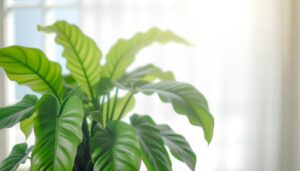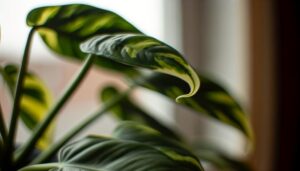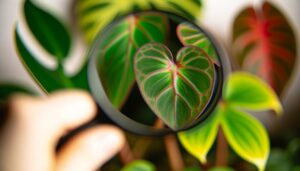What Is a Green Philodendron Micans?
The Green Philodendron Micans, hailing from Central and South American tropical rainforests, is an intriguing member of the Araceae family. Known for its velvety, heart-shaped leaves with an iridescent sheen, it displays hues shifting between green, bronze, and burgundy.
The plant thrives in environments with medium to bright indirect light, high humidity, and consistently moist, well-draining soil rich in organic matter. Aerial roots aid in moisture and nutrient absorption, while its trailing growth habit makes it ideal for hanging baskets.
Properly maintained conditions enhance its lush foliage and vibrant appearance, hinting at more fascinating care details to explore.
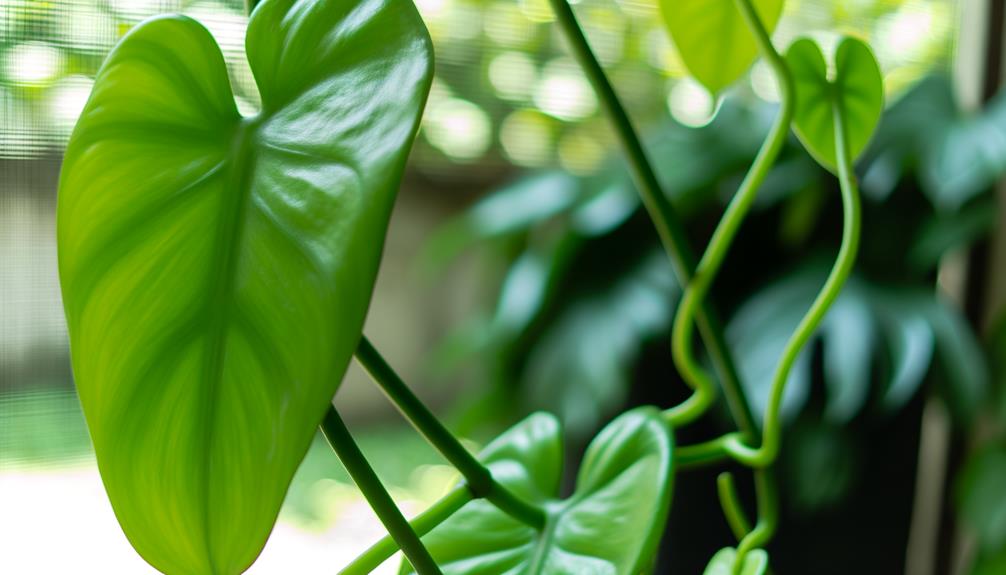
Key Takeaways
- Philodendron micans is a tropical plant from Central and South American rainforests.
- It features velvety, heart-shaped leaves with iridescent hues of green, bronze, and burgundy.
- The plant thrives in indirect, medium to bright light and high humidity.
- It has a trailing growth habit and can be used in hanging baskets or climbing structures.
- Propagation is typically done through stem cuttings with high humidity and indirect light.
Plant Origins
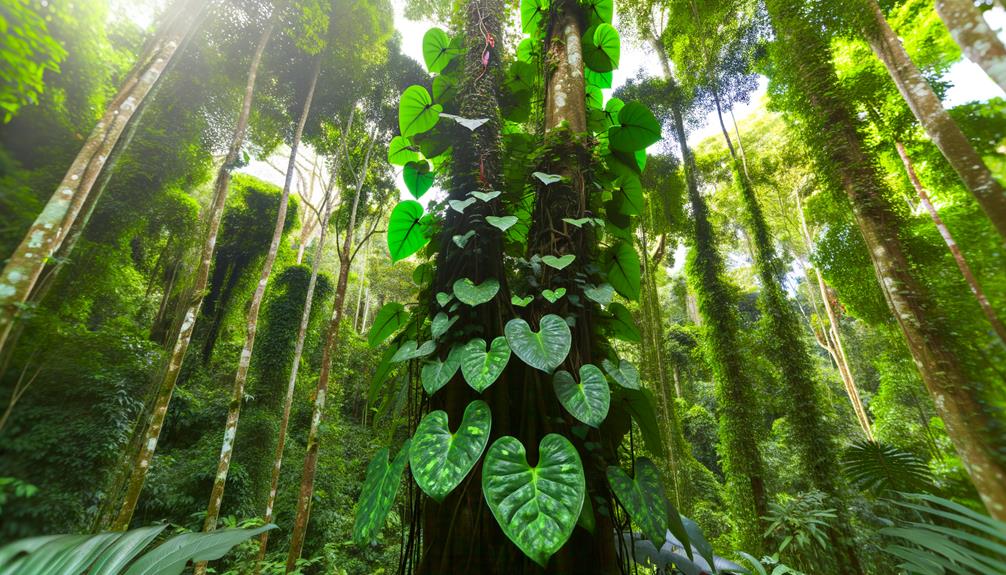
The Philodendron micans, a member of the Araceae family, originates from the tropical rainforests of Central and South America. This region's climate, characterized by high humidity and consistent rainfall, provides an excellent environment for the species.
These perennial plants thrive under the forest canopy, where they are exposed to filtered light. The native habitat's soil composition, rich in organic matter and well-draining, contributes to their robust growth.
The ecological niche of P. micans involves climbing and spreading across the forest floor, utilizing aerial roots for support and nutrient absorption. Understanding the plant's origins is essential for replicating its natural conditions in cultivation, ensuring excellent health and growth in domestic settings.
Unique Features
Characterized by their velvety, heart-shaped leaves, Philodendron micans exhibit a striking iridescence that shifts between shades of green, bronze, and burgundy depending on the light angle. This unique foliar trait is due to the presence of microscopic trichomes on the leaf surface, which reflect and refract light.
The leaves typically measure between 2 to 4 inches in length and possess a delicate, soft texture that distinguishes them from other Philodendron species. Additionally, the plant exhibits a trailing growth habit, making it ideal for hanging baskets or as a climbing plant when provided with support.
The stems are slender yet robust, capable of producing aerial roots that enhance its ability to absorb moisture and nutrients from the environment.
Ideal Growing Conditions
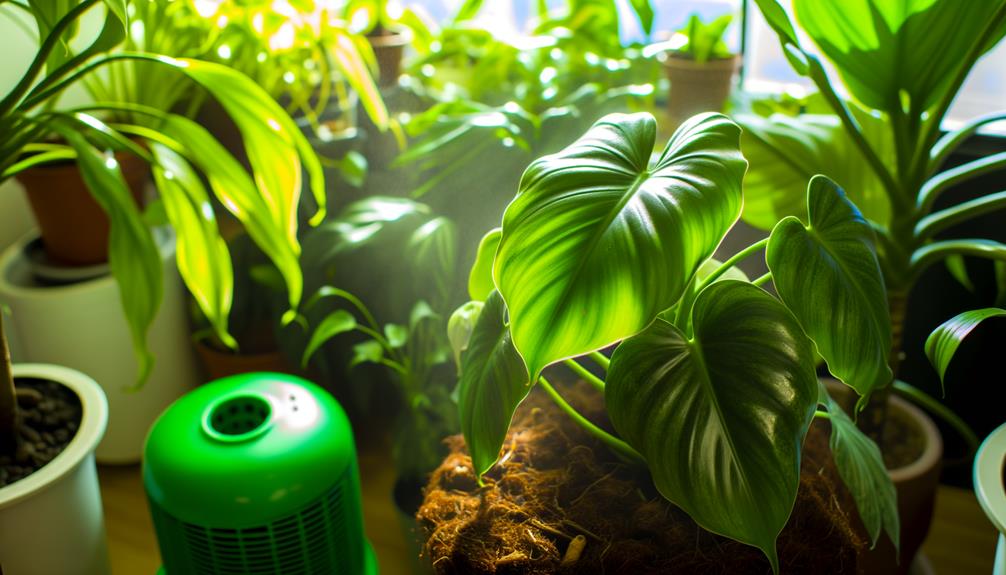
To optimize the growth of Philodendron micans, it is essential to provide specific conditions:
- The species thrives in indirect, medium to bright light.
- It prefers temperatures ranging from 18°C to 26°C.
- Maintaining consistent soil moisture and high humidity is vital to support its lush, velvety foliage.
Light and Temperature
Maintaining perfect growth for the Philodendron micans necessitates specific light and temperature conditions. This epiphytic plant thrives in bright, indirect light, mirroring its native tropical understory habitat. Direct sunlight can cause leaf scorch and impede photosynthesis, whereas low light can stunt growth and reduce pigmentation.
Best temperature ranges between 65-80°F (18-27°C) are essential for metabolic processes and enzymatic activities. Temperatures below 55°F (13°C) can trigger physiological stress, impairing cellular function. It is vital to avoid sudden temperature fluctuations, which can disrupt homeostasis.
Additionally, maintaining a stable microenvironment, free from drafts and extreme conditions, supports optimal growth. By following these guidelines, one can ensure the Philodendron micans flourishes, displaying its characteristic vibrant foliage.
Watering and Humidity
Maintaining ideal watering and humidity levels is crucial for the thriving growth of Philodendron micans, as it closely mimics their natural tropical environment. This plant species requires consistently moist but not waterlogged soil. Overwatering leads to root rot, while underwatering results in leaf curl and browning. Employ a well-draining potting mix to guarantee optimal water retention and aeration.
Philodendron micans flourish in relative humidity levels between 60-80%. To achieve this, utilize a humidity tray, mist the foliage regularly, or use a humidifier. Monitoring ambient humidity with a hygrometer guarantees precise control.
Proper watering and humidity management are essential for maintaining the plant's vibrant, velvety leaves and overall health.
Light Requirements
Requiring moderate to bright indirect light, the Philodendron Micans thrives best when placed in environments that emulate its native tropical understory. This epiphytic plant prefers dappled sunlight, mimicking the filtered light that penetrates through the dense canopy of rainforests.
Excessive direct sunlight can lead to leaf scorching, characterized by brown edges and tips, while insufficient light results in leggy growth and diminished leaf coloration. Optimal placement involves east or north-facing windows, ensuring protection from intense afternoon sun.
Artificial grow lights can supplement natural light, particularly in less illuminated interiors. Maintaining consistent light levels is essential for the plant's photosynthesis and overall vigor, promoting lush, velvety foliage that remains vibrant and healthy.
Watering Needs
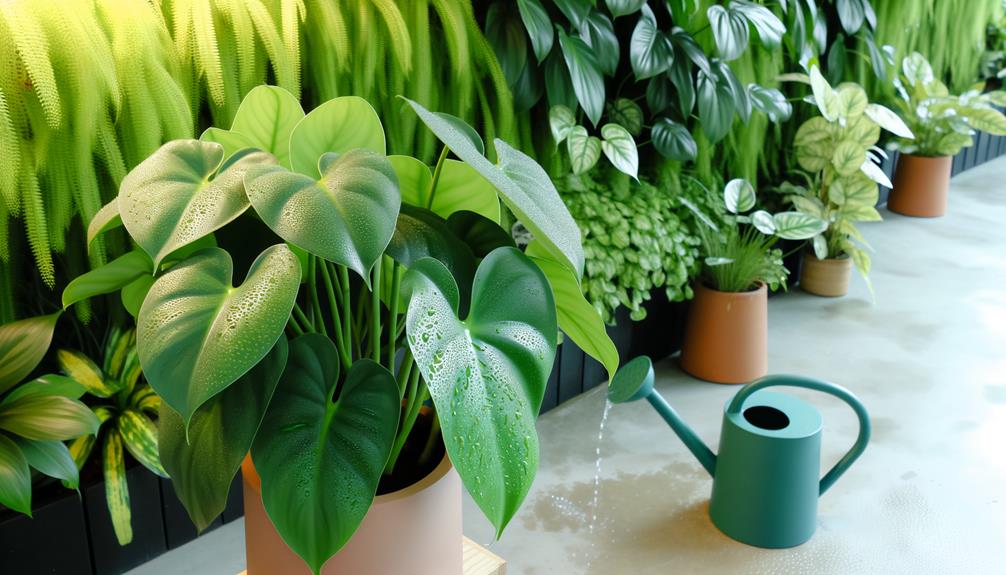
Proper hydration of the Philodendron Micans involves allowing the top inch of soil to dry out between waterings to prevent root rot and promote ideal growth conditions. This moisture management guarantees the plant's roots access sufficient oxygen, mitigating anaerobic conditions detrimental to root health.
Utilize a moisture meter to ascertain precise soil moisture levels or manually test by inserting a finger into the substrate. Employing tepid, dechlorinated water minimizes physiological stress and potential damage from chlorine or fluoride.
Consistent watering intervals tailored to ambient humidity, temperature, and light intensity are essential. Excess water should drain freely to avoid waterlogging, necessitating the use of well-draining pots equipped with adequate drainage holes.
Regular monitoring and adjustments are vital for optimal hydration and plant vitality.
Soil Preferences
Green Philodendron Micans flourishes in a well-draining soil matrix that prevents water stagnation, thereby reducing the risk of root rot.
Incorporating organic matter, such as compost or peat moss, enhances nutrient availability and promotes microbial activity critical for root health.
Peak growth is achieved in soil with a slightly acidic to neutral pH range, ideally between 5.5 and 7.0.
Well-Draining Soil Importance
The Philodendron micans flourishes in well-draining soil, which is crucial for preventing root rot and ensuring ideal aeration. Well-draining soil facilitates the rapid percolation of water, reducing the risk of waterlogged conditions that can lead to anaerobic environments detrimental to root health.
This type of soil structure maintains a balance between moisture retention and air pockets, promoting optimal root respiration and nutrient uptake. The inclusion of inorganic components like perlite or pumice enhances drainage by creating channels for excess water to escape.
Additionally, an appropriate soil mix prevents the compaction often associated with dense substrates, further improving the plant's overall health. Ensuring these conditions contributes to the robust growth and well-being of the Philodendron micans.
Organic Matter Benefits
In addition to well-draining properties, incorporating organic matter into the soil mix enhances the nutrient profile and microbial activity, fostering a thriving environment for Philodendron micans.
Organic matter, such as compost or decomposed leaf litter, serves multiple essential functions:
- Nutrient Enrichment: Organic matter decomposes, releasing essential macro and micronutrients, necessary for the plant's growth.
- Soil Aeration: It improves soil structure, creating air pockets that aid root respiration and water infiltration.
- Microbial Activity: It supports beneficial microbes, which decompose organic material, releasing nutrients in a form usable by the plant.
- Moisture Retention: Organic components enhance the soil's water-holding capacity, ensuring consistent moisture availability without waterlogging.
These benefits collectively create an ideal growing medium for Philodendron micans.
Ideal Ph Levels
Ideal pH levels for Philodendron micans range between 5.5 and 6.5, which provides a slightly acidic environment conducive to nutrient uptake and overall plant health. This pH range enhances the availability of essential macronutrients such as nitrogen, phosphorus, and potassium, while also facilitating the absorption of critical micronutrients like iron, manganese, and zinc.
Maintaining soil within this pH spectrum helps to prevent nutrient lockout, which can lead to deficiencies and reduced growth rates. Regular monitoring of soil pH using a reliable pH meter is recommended. If the pH strays outside this best-suited range, amendments such as sphagnum peat moss (to lower pH) or agricultural lime (to raise pH) can be employed to correct the soil conditions.
Fertilization Tips
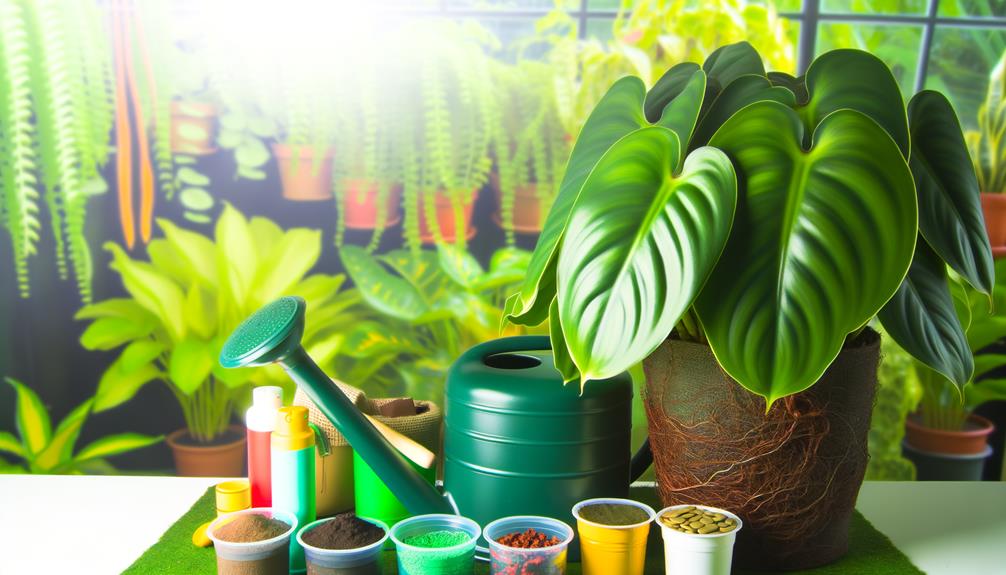
Understanding the specific nutrient requirements of the Green Philodendron Micans is crucial for optimizing its growth and promoting vibrant, healthy foliage. This epiphytic plant thrives when provided with a balanced fertilization regimen.
Here are key fertilization tips:
- Fertilizer Type: Use a balanced, water-soluble fertilizer with an N-P-K ratio of 20-20-20 to maintain even nutrient distribution.
- Frequency: Fertilize bi-monthly during the growing season (spring and summer) to support active growth phases.
- Dilution: Dilute the fertilizer to half the recommended strength to prevent root burn and nutrient overload.
- Application: Apply fertilizer directly to the soil, avoiding foliar feeding, to promote proper nutrient absorption through the root system.
Adherence to these guidelines will greatly enhance the plant's vigour.
Common Pests
Encountering common pests such as spider mites, aphids, and mealybugs can have a significant impact on the health and aesthetic quality of Green Philodendron Micans.
Spider mites, tiny arachnids, cause stippling and discoloration by piercing plant cells to feed on sap. Aphids, small sap-sucking insects, excrete honeydew, leading to sooty mold and stunted growth. Mealybugs, covered in a white, waxy coating, form clusters at leaf nodes, exuding honeydew and facilitating fungal infections.
Regular inspection and prompt treatment are essential for mitigating infestations. Utilizing insecticidal soaps or neem oil, along with maintaining ideal humidity and cleanliness, can effectively manage these pests, preserving the plant's vigor and ornamental appeal.
Propagation Methods
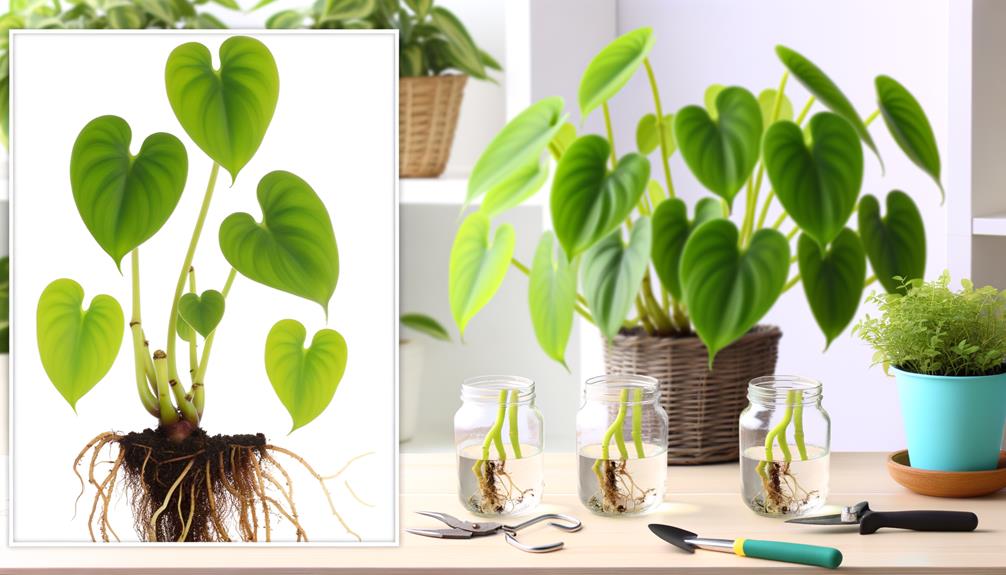
Propagation of Green Philodendron Micans can be efficiently achieved through stem cuttings. This process involves selecting healthy nodes, proper cutting, and rooting in either water or a well-draining soil medium.
To guarantee successful propagation, follow these steps:
- Node Selection: Choose a stem with at least one healthy node. Nodes contain the necessary meristematic tissue for root development.
- Cutting Technique: Use a sterilized, sharp blade to make a clean cut just below the selected node. This helps minimize tissue damage.
- Rooting Medium: Place the cutting in water or a well-draining soil mix. A mix containing perlite and peat moss can promote root growth.
- Environmental Conditions: Maintain high humidity and indirect light. These conditions support the rooting process, ensuring the cutting remains healthy.
Conclusion
To sum up, the green Philodendron micans, with its shimmering foliage and adaptable growth needs, stands as proof of the flexibility and strength present in nature's plant diversity.
Like a well-crafted tool in a musical ensemble, this plant blends seamlessly with its surroundings, flourishing under particular light, water, and soil conditions.
Adequate care guarantees it stays pest and disease-free, while suitable propagation methods enable the continuation of its enchanting beauty.

